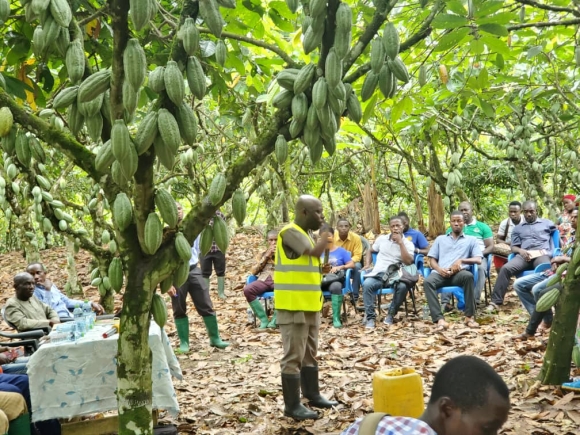The Western South Cocoa Region of the Ghana Cocoa Board has organised a farmer field school at Bompieso in the Huni Valley District in the Western Region to sensitise farmers to adopt artificial hand pollination as one of the core agronomic activities.
The effort is intended to improve cocoa yield over the period to shore up farmers and the country’s earnings from the crop.
The field school was held under the leadership of the Regional Manager of COCOBOD, Samuel Osei, with the support of the Regional Extension Officer, Dr. Elliot Anyidoho, and the District Cocoa Officer of Huni Valley, Clement Sarpong.
Mr Osei said the region was poised to artificially hand-pollinate 43,000 hectares of cocoa farms this year.
To achieve this, the region has trained and refreshed 3,551 skilled pollinators and 41,125 farmers from 2,409 cooperatives.
In addition, Mr Osei said, there would be free agrochemicals and extension service delivery for participating farmers to reduce costs.
Ghana’s cocoa industry is operating below its potential yield levels, and its continued competitiveness as the second-largest producer of cocoa beans is threatened by the current low productivity.
The threat of the declining population of midges and other natural cocoa flower pollinators has the potential to worsen the underlying causes of low productivity.
The Ghana Cocoa Board, through the Cocoa Health and Extension Division (CHED), recognised the urgent need to address this threatening issue when it rolled out artificial hand pollination in 2017 in all the cocoa-growing regions in Ghana to increase cocoa productivity.
Mr Osei said there would be free agrochemicals and extension service delivery for participating farmers to reduce costs.
The region has, therefore, planned a series of farmer field schools to showcase the farms that were successfully hand-pollinated to encourage other farmers, cooperative leaders, chief farmers, and opinion leaders to adopt.
The regional manager demystified the negative perception that artificial hand pollination was expensive and thus, was meant for rich cocoa farmers as well as the idea that, it has the potential to kill cocoa trees.
According to him, what was essential was for the farms to be fertilised yearly to improve the soil nutrients for the trees to be nourished.
Tour
As part of the farmer field school, the participants toured one of the successful farms in the area, 2.83 hectares pollinated farm belonging to Mr. Kwame Alex and were extremely inspired by the enhanced crop output owing to artificial hand pollination. The farm has an average of 115 pods per tree and many of the participants were amazed at the results.
Benefits
Highlighting the cost-benefit analysis of an acre of the pollinated farm, Mr Osei indicated that, a one-acre cocoa farm that was artificially hand-pollinated could produce between 16 to 32 bags of cocoa beans.
"Therefore, there is no denying the fact that the benefits of artificial hand pollination far outweigh the costs," Mr Osei said.
"I, therefore, called for a massive adoption of the artificial hand pollination as part of agronomic activities that will not only create wealth for cocoa farmers but will also create jobs for the teaming youth, societies and Ghana as a whole," he added.
He assured cocoa farmers of technical and input support, especially to those who adopt the new practice.
Mr Osei charged participants to spread the news to all cocoa farmers in the region to adopt the technique.
About hand pollination
Hand Pollination is used to supplement natural pollination in areas where natural pollination is either irregular or deficient to increase pod development.

